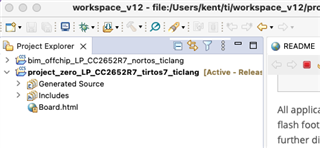Other Parts Discussed in Thread: CCSTUDIO, CC2652R7, UNIFLASH,
Tool/software:
I am having trouble getting started with the LaunchPad board. I am trying to port an application I have written for another (non-ti) part to the device, but am having all kinds of trouble getting my footing with the development tools and the SDKs. I am new to the TI tools, but have decades of experience with embedded development and Bluetooth.
What I am hoping for is a "state of the development environment" as of July 2024 so that I know what should work and which tools I should be using. I am trying to develop on both ARM and Motorola Macs.
I first downloaded and tested the iPhone "Simplelink Started" app & successfully tested the lights & switches functions of the app with the factory software in the LaunchPad.
I then tried to compile and install the "project_zero" software so that I could validate I had a working development environment.
I tried installing the CCStudio IDE (Theia Framework), but could not locate the proper SDK to allow me to develop with the CC2652R7. Found many broken links in the documentation so I don't know if I just couldn't find the proper SDK or if it's not supported. The documentation said "most targets" are supported by the "newer Theia" framework, but of course I only care about the CC2652R7 and I found no indication one way or the other.
I then tried installing the (classic) Eclipse CCStudio IDE (Version: 12.7.1.00001) and found an SDK for the CC2652R7 (ie simplelink_cc13xx_cc26xx_sdk_7_41_00_17). I copied the examples to my "Project Explorer", and used the "Build" links as described in getting started to build the "bim" and "project_zero" targets. A copy of the project explorer is shown below.

I then used the "Debug As" link to install software and had both "bim" and "project_zero" stop at break. However, when I restarted the software only the Left button (BTN-1) would be displayed on the the iPhone App. The LED buttons on the iPhone app also no longer controlled the lights on the LP -- the lights stay off. I didn't fire up any debug tools (eg WireShark) to decode what was going on as I was just trying to debug development environment, not the software.
I then tried to follow the instructions at LP-CC2652R7: restore orignial firmware using the cloud UNIFLASH installer. I could not find exact matching hex file names (ie there was not file name ending in "_oad.bin". I used the following command to look for files in the SDK. I used the Release/bim_offchip.hex and project_zero_unsecure_app.hex, but got same result as before. Most likely I failed to program anything using the cloud programmer.
% cd ~/ti/simplelink_cc13xx_cc26xx_sdk_7_40_00_77 % find examples -name \*.hex | grep -i cc2652r7 examples/nortos/LP_CC2652R7/bim/hexfiles/bim_dual_onchip/Release/bim_dual_onchip.hex examples/nortos/LP_CC2652R7/bim/hexfiles/bim_dual_onchip/Debug/bim_dual_onchip.hex examples/nortos/LP_CC2652R7/bim/hexfiles/bim_offchip/Release_unsecure/bim_offchip.hex examples/nortos/LP_CC2652R7/bim/hexfiles/bim_offchip/Debug_unsecure/bim_offchip.hex examples/nortos/LP_CC2652R7/bim/hexfiles/bim_offchip/Release/bim_offchip.hex examples/nortos/LP_CC2652R7/bim/hexfiles/bim_offchip/Debug/bim_offchip.hex examples/nortos/LP_CC2652R7/bim/hexfiles/bim_onchip/Release_unsecure/bim_onchip.hex examples/nortos/LP_CC2652R7/bim/hexfiles/bim_onchip/Debug_unsecure/bim_onchip.hex examples/nortos/LP_CC2652R7/bim/hexfiles/bim_onchip/Release/bim_onchip.hex examples/nortos/LP_CC2652R7/bim/hexfiles/bim_onchip/Debug/bim_onchip.hex examples/rtos/LP_CC2652R7/prop_rf/hexfiles/offChipOad/erase_storage_offchip_cc13x2lp.hex examples/rtos/LP_CC2652R7/prop_rf/hexfiles/offChipOad/ticlang/rfOADClientExtFlash_LP_CC2652R7_app_v2.hex examples/rtos/LP_CC2652R7/prop_rf/hexfiles/offChipOad/ticlang/rfOADClientExtFlash_LP_CC2652R7_app_v1.hex examples/rtos/LP_CC2652R7/prop_rf/hexfiles/offChipOad/ticlang/rfOADClientExtFlash_LP_CC2652R7_all_v1.hex examples/rtos/LP_CC2652R7/prop_rf/hexfiles/offChipOad/bim_offchip.hex examples/rtos/LP_CC2652R7/prop_rf/hexfiles/onChipOad/bim_onchip.hex examples/rtos/LP_CC2652R7/prop_rf/hexfiles/onChipOad/ticlang/rfOADClientIntFlashUApp_LP_CC2652R7_app_v2.hex examples/rtos/LP_CC2652R7/prop_rf/hexfiles/onChipOad/ticlang/rfOADClientIntFlashPApp_LP_CC2652R7_all.hex examples/rtos/LP_CC2652R7/prop_rf/hexfiles/onChipOad/ticlang/rfOADClientIntFlashUApp_LP_CC2652R7_app_v1.hex examples/rtos/LP_CC2652R7/prop_rf/hexfiles/onChipOad/ticlang/rfOADClientIntFlashPApp_LP_CC2652R7.hex examples/rtos/LP_CC2652R7/prop_rf/hexfiles/MCUBootOad/ticlang/rfOADClient_LP_CC2652R7_app_v1.hex examples/rtos/LP_CC2652R7/prop_rf/hexfiles/MCUBootOad/ticlang/rfOADClient_LP_CC2652R7_app_v2.hex examples/rtos/LP_CC2652R7/prop_rf/hexfiles/MCUBootOad/ticlang/rfOADClient_LP_CC2652R7_all_v1.hex examples/rtos/LP_CC2652R7/prop_rf/hexfiles/MCUBootOad/mcuboot_LP_CC2652R7.hex examples/rtos/LP_CC2652R7/ble5stack/hexfiles/simple_central_app.hex examples/rtos/LP_CC2652R7/ble5stack/hexfiles/simple_peripheral_app.hex examples/rtos/LP_CC2652R7/ble5stack/hexfiles/project_zero_unsecure_app.hex examples/rtos/LP_CC2652R7/ble5stack/hexfiles/host_test_app.hex % find examples -name \*.bin | grep -i cc2652r7 examples/rtos/LP_CC2652R7/prop_rf/hexfiles/offChipOad/ticlang/rfOADClientExtFlash_LP_CC2652R7_app_v1.bin examples/rtos/LP_CC2652R7/prop_rf/hexfiles/offChipOad/ticlang/rfOADClientExtFlash_LP_CC2652R7_app_v2.bin examples/rtos/LP_CC2652R7/prop_rf/hexfiles/onChipOad/ticlang/rfOADClientIntFlashUApp_LP_CC2652R7_app_v1.bin examples/rtos/LP_CC2652R7/prop_rf/hexfiles/onChipOad/ticlang/rfOADClientIntFlashUApp_LP_CC2652R7_app_v2.bin examples/rtos/LP_CC2652R7/prop_rf/hexfiles/onChipOad/ticlang/rfOADClientIntFlashPApp_LP_CC2652R7.bin
I then installed the "cloud" version using the Chrome browser on the M1 Mac. A screen shot of the environment is shown below.

When I tried to select "build", I got repeated error messages "Trouble Halting Target CPU: (Error -2064 @ 0)".
When I tried to follow the "Getting started guide" I got this:

Obviously, I'm flailing. If you could point me to the best supported environment, with complete URLs (as of July 2024) I'd appreciate it. I would also like instructions for how to restore the LP-CC2652R7 firmware to it's original state as well.
Sorry for the long post, but I wanted to show what I'd done so it would be obvious to someone who knows what they are doing what I've done wrong.
Thanks.




